Abstract
An aged black patient diagnosed as having Virchowian hanseniasis as well as gangliar tuberculosis, after presenting an outbreak of Erythema nodosum in his first year of treatment, is interned with a reaction characterized by diffuse infiltration of cutaneous erythema, intense edema of the hands and feet, and necrotic lesions of the vasculites type in the lower members which later evolve into extensive necrotic ulcers in the anterior segments of the feet. The patient died in shock. The findings of the autopsy showed a granulomatous tuberculoid reaction spread in neural-cutaneous mucous and visceral areas affected by Virchowian hanseniasis. Especially remarkable is the almost generalized involvement of the veins the affected areas as a result of granulomatous reaction in all levels of the vascular wall. In the extremities there is a clear correlation between these vasculites which affect small veins and arteries and the cutaneous necroses. The explana- tion given for these findings is that during treatment this patient presented a reactional outbreak of the pseudo-exacerbation type or a "reversal reaction" which arbitrarily affected small veins. The hansenic etiology of these vasculites was confirmed by the following facts: 1 The vasculites appeared only in areas usually affected by hanseniasis. 2 There was, concomitantly, an involvement of the adjacent nerve endings by granulomas with the same characteristics. 3 Bacilli were found in granulomas of the vascular wall, in non-affected vascular fragments and in veins untouched by the granulomatous reaction. The hypothesis raised is that the ganglionar tuberculosis may have altered the patient's immuno-allergic state thus favoring a granulomatous reaction having strong tuberculoid characteristics and with a great capability of harming veins and nerves.
This journal is licensed under a Creative Commons Attribution 4.0 International License.
